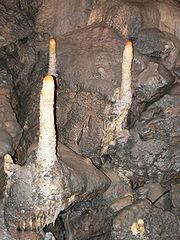
Poole's Cavern
Encyclopedia


Buxton
Buxton is a spa town in Derbyshire, England. It has the highest elevation of any market town in England. Located close to the county boundary with Cheshire to the west and Staffordshire to the south, Buxton is described as "the gateway to the Peak District National Park"...
in the Peak District
Peak District
The Peak District is an upland area in central and northern England, lying mainly in northern Derbyshire, but also covering parts of Cheshire, Greater Manchester, Staffordshire, and South and West Yorkshire....
, in the county of Derbyshire
Derbyshire
Derbyshire is a county in the East Midlands of England. A substantial portion of the Peak District National Park lies within Derbyshire. The northern part of Derbyshire overlaps with the Pennines, a famous chain of hills and mountains. The county contains within its boundary of approx...
, England. Daniel Defoe
Daniel Defoe
Daniel Defoe , born Daniel Foe, was an English trader, writer, journalist, and pamphleteer, who gained fame for his novel Robinson Crusoe. Defoe is notable for being one of the earliest proponents of the novel, as he helped to popularise the form in Britain and along with others such as Richardson,...
has been quoted as calling the cavern one of the wonders of the Peaks, although he actually called it 'another of the wonderless wonders of the Peak'.
A natural cavern, Poole's forms part of the Wye
River Wye, Derbyshire
The River Wye is a limestone river in the Peak District of Derbyshire, England. It is in length, and is one of the major tributaries of the River Derwent, which flows into the River Trent, and ultimately into the Humber and the North Sea....
system, and has been designated a Site of Special Scientific Interest
Site of Special Scientific Interest
A Site of Special Scientific Interest is a conservation designation denoting a protected area in the United Kingdom. SSSIs are the basic building block of site-based nature conservation legislation and most other legal nature/geological conservation designations in Great Britain are based upon...
. The name derives from an outlaw, Poole, who reputedly used the cave as a lair and a base to rob travellers in the fifteenth century. Archeological explorations in 1981 and 1983 have suggested that the cave was occupied from the Bronze Age. Some of the finds have been interpreted as suggesting that one of the chambers was used for religious purposes by Romano-Britons; an alternative explanation is that the cave was a metal-workers' workshop.
Officially opened as a show cave in 1853 by the 6th Duke of Devonshire
William Cavendish, 6th Duke of Devonshire
William George Spencer Cavendish, 6th Duke of Devonshire KG, PC , styled Marquess of Hartington until 1811, was a British peer, courtier and Whig politician...
, the cave was already a tourist attraction, being listed as one of the Wonders of the Peak by Charles Cotton
Charles Cotton
Charles Cotton was an English poet and writer, best known for translating the work of Michel de Montaigne from the French, for his contributions to The Compleat Angler, and for the highly influential The Compleat Gamester which has been attributed to him.-Early life:He was born at Beresford Hall...
in 1683. Mary, Queen of Scots, is claimed to have been an early visitor. Under the management of the Duke's overseer, Frank Redfern, the entrance was widened and, in 1859, a system of gas lamps was installed to light the caverns (one of the earliest uses of gas in this context), which remained in use until the cave closed in 1965. It reopened in 1976.
The region currently open to the public is around 310 m in length, and includes chambers named the Roman Chamber, Great Dome, Poached Egg Chamber and Sculpture Chamber. Features of interest include large stalactites/stalagmites called the 'Flitch of Bacon' and 'Mary Queen of Scots' Pillar', as well as stalagmites with a porous texture and 'poached egg' colour, which has been attributed to minerals leached from lime-burning on Grin Low above. Part of the cavern is accessible to wheelchairs. The cave system is believed to extend further, but has not been explored.

